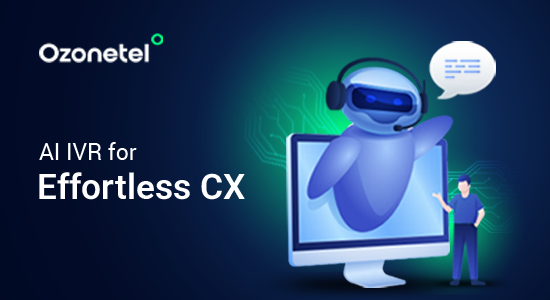- Resources
- How Voice of the Customer Can Drive Value and Accelerate Your Business Growth
How Voice of the Customer Can Drive Value and Accelerate Your Business Growth

Voice of the Customer (VoC) is all about listening to your customers and understanding their needs, concerns, and preferences. It helps bridge the gap between what you offer and what your customers actually expect.
How? VOC focuses on more than just customer feedback – it helps you turn that feedback into strategies that connect better with your customers. This information also guides everything from product development to customer service improvements, making sure that you are always in tune with what matters most to your audience.
Let us understand more about how exactly VoC benefits your business.
What is Employee Experience?
Employee Experience (EX) is the overall perception employees have of their journey within an organization. It encompasses every interaction and touchpoint, from recruitment and onboarding to daily responsibilities, support systems, and eventual offboarding.
Key Benefits of Voice of Customer

Unlike surface-level feedback, Voice of Customer captures the root causes behind customer behavior, allowing you to design solutions that truly connect with them. These insights also allow you to streamline operations to eliminate inefficiencies and adapt proactively to market demands.
So, let’s break down the benefits in detail to help you understand why VOC should be integral to your decision-making.
Increase Sales
When you prioritize the customer experience, sales naturally follow. In fact, brands that focus on customer-centricity see 60% higher profits. Additionally, VOC insights can also boost cross-selling and upselling success rates by up to 20%
Take Volkswagen as an example: by integrating customer feedback on sustainability, they developed electric vehicles tailored to consumer preferences. This not only drove sales but positioned them as a leader in the growing EV market, proving that listening to your customers can significantly impact the bottom line.
Increased Customer Retention
Listening to customers isn’t just a good practice—it directly impacts loyalty. Forrester research shows that customers are 2.4 times more likely to stay loyal to brands that actively address their concerns. Additionally, Bain & Co. reports that voice of customer analytics can increase retention rates by up to 55%.
Take McDonald’s as an example. By analyzing customer feedback on delivery speed and menu preferences, they introduced new options like personalized meal bundles, leading to improved satisfaction and repeat visits. When you prioritize listening and solving problems, you create a foundation for long-term customer relationships.
Become a Market Leader
A great customer experience sets you apart in competitive markets by turning your customers into advocates. How? Research shows that 72% of customers share positive experiences with others, building your reputation organically.
For example, relentless focus on customer feedback—whether it’s about product design or functionality—has helped them maintain their market leader status. They listen, innovate, and exceed expectations, keeping customers loyal and willing to invest in their products again and again.
Build Trust and Confidence
71% of customers say they would lose trust in a company forever if they believed it prioritized profit over people. VOC programs allow you to bridge this gap by identifying concerns and resolving them transparently.
For instance, brands that focus on efficiency and convenience—the top customer priorities according to PWC—build trust by delivering seamless and personalized experiences. This not only prevents churn but also fosters long-term loyalty, showing customers they are valued.
Drive Customer Spending
Happy customers spend 140% more on average and are more inclined to try additional products. VOC insights help identify pain points and opportunities to offer products or services that customers did not know they wanted, increasing spending potential.
Research also shows that 65% of customers value a great experience more than great advertising. When you focus on creating remarkable customer experiences, customers will naturally increase their spending and stay loyal.
Better Decision Making
Brands often face decision-making challenges when there is a lack of alignment between strategy and customer expectations. VOC eliminates guesswork by presenting quantifiable customer insights that can guide product development, marketing strategies, and even pricing models.
For example, if customers frequently mention the need for faster delivery, data from VOC analytics can justify investing in logistics improvements. With clear data, decisions become more targeted and effective.
Optimize Product Development
VOC tools allow companies to continuously adapt their offerings based on what customers need, want, or dislike about existing products. This helps brands stay competitive by refining products to better meet customer demands.
For instance, Porsche’s product team used VOC feedback to shape the Cayenne, conducting surveys and gauging customer preferences for specific car features. Their understanding of what customers were willing to pay for led to annual sales of around 100,000 units, demonstrating the power of customer-driven product development.
Improved Marketing Efforts
Word-of-mouth remains one of the most powerful marketing tools, and customers trust their peers over company advertisements. VOC analysis gives businesses the ability to view their products from a customer’s perspective, learning what resonates and where improvements are needed.
Talking about the McDonald’s example – their use of VOC insights to understand customer preferences helped them revamp their menu, focusing on health-conscious options. This not only improved customer satisfaction but also made marketing campaigns more targeted and effective, as they could directly speak to what their customers valued.
Top Examples of Voice of Customer in Business
To get the most of these benefits, many top companies have implemented effective VoC strategies that help them gather valuable insights directly from customers, improving their satisfaction. Here are some prime examples of how businesses are successfully capturing VOC:
PM-JAY

The National Health Authority (NHA) of India leveraged Ozonetel’s AI-powered speech analytics to automate call quality audits for over 900 healthcare advisors supporting PM-JAY. Sentiment analysis of more than 122,000 hours of conversations helped pinpoint areas for advisor training, improving first-contact resolution and boosting citizen satisfaction.
How you can implement it:
- Automate call monitoring: Use AI tools to monitor and evaluate calls automatically, focusing on key performance metrics like tone, sentiment, and call duration.
- Sentiment analysis: Implement sentiment analysis to track customer emotions during interactions, enabling better identification of frustrated or satisfied callers.
- Identify training gaps: Use AI-driven insights to identify areas where your team may need additional training based on sentiment and conversation quality.
BigBasket

BigBasket excels in capturing the Voice of the Customer through extensive data collection methods such as NPS surveys, customer service feedback, and behavior analysis. Their approach allows them to understand customer preferences and act on them, ensuring they meet or exceed customer expectations.
How you can implement it:
- Use multi-channel feedback systems: Capture customer feedback from multiple touchpoints, including surveys, support calls, social media, and website interactions.
- Leverage sentiment analysis: This allows you to gauge the emotional tone behind customer messages, enabling you to identify dissatisfaction, issues, or areas for improvement quickly and accurately.
- Establish continuous feedback loops: Implement regular follow-up surveys and in-app feedback mechanisms to ensure you gather fresh insights after each purchase or interaction.
Starbucks

Starbucks collects real-time data through its mobile app and loyalty program. This helps track customer preferences, purchasing habits, and engagement levels, allowing Starbucks to adjust its services, menu items, and store operations accordingly.
How you can implement it:
- Leverage multiple VoC data sources: Combine surveys, loyalty programs, and social listening for a complete view of customer sentiments.
- Integrate VoC into digital touchpoints: Make it easy for customers to provide feedback through apps and online platforms.
- Use VoC insights to drive continuous improvement: Regularly analyze feedback to refine your offerings and enhance customer loyalty.
LEGO

LEGO uses in-depth ethnographic research, including home visits and focus groups, to gain insights into how children interact with their toys. These insights help LEGO design products that better align with customer needs and creativity.
How you can implement it:
- Prioritize user-centric research: Observe and engage customers in their natural environments for deeper insights.
- Engage customers as co-creators: Involve loyal customers in the design process by building online communities.
- Integrate VoC across the organization: Collect feedback from various channels to inform your decision-making.
Marriott

Marriott uses its loyalty programs to track customer preferences and stay history. Along with online reviews and post-stay surveys, Marriott gathers data to personalize guest experiences and identify areas for service improvement.
How you can implement it:
- Leverage loyalty program data: Encourage customers to join loyalty programs for rich, personalized insights.
- Monitor online reputation: Track reviews across third-party sites to address customer concerns in real time.
- Integrate VoC across touchpoints: Collect feedback from various sources like surveys, social media, and customer service.
Spotify

Spotify uses customer listening data to understand user preferences and recommend personalized music, podcasts, and playlists. Through continuous tracking of user behavior, the company gathers insights on listening habits, refining recommendations in real-time.
How you can implement it:
- Leverage first-party user data: Use customer behavior data to personalize the user experience.
- Embed VoC collection within the product: Add easy-to-use feedback tools directly in your platform.
- Combine quantitative and qualitative insights: Gather feedback from both direct surveys and behavioral data to gain a comprehensive understanding.
Mistakes to Avoid in Voice of Customer Programs

Voice of Customer programs can significantly impact your business when done right, but mistakes along the way can derail your efforts. Here are some of the key mistakes to watch out for:
Not Defining VOC Clearly
Without a proper definition, your VOC program risks gathering the wrong data or misinterpreting feedback. This means that your VOC should be focused on collecting and analyzing customer opinions, feedback, and emotions to guide decisions that improve products, services, and overall satisfaction.
Designing Poor VOC Programs
A poorly designed VOC program can frustrate customers rather than collect valuable insights. Moreover, long, tedious surveys, intrusive feedback requests, or badly worded questions can lead to inaccurate data or disengaged customers. Instead, make sure your VOC surveys and tools are user-friendly, clear, and concise to gather actionable insights without causing frustration.
Failing to Use the Right Tools
Without using the right tools—like surveys, sentiment analysis, or automated feedback systems—you’ll struggle to keep up with feedback volume and fail to extract valuable insights. So, ensure that your VOC program includes efficient systems tailored to your business needs for better results.
Not Making VOC an Ongoing Process
Neglecting to continuously gather and act on customer feedback can often lead to stagnation. Therefore, regularly update your VOC strategies, adapt to changing customer needs, and take consistent action based on the feedback you receive.
Lacking Clear Goals
Every VOC program should start with clear goals that align with your business objectives. Whether it’s improving market fit, enhancing customer service, or driving product innovation, knowing your purpose will guide your efforts and ensure you stay focused on the right problems.
Voice of Customer Program: Challenges & Solutions

VoC programs provide valuable insights into customer needs, preferences, and pain points. However, businesses often encounter several challenges when implementing these programs effectively. Here are challenges and the actionable steps taken to solve them to ensure VoC program success.
Low Response Rates
When customer participation is low, the feedback collected becomes less representative and limits the insights a business can gain. This lack of engagement can lead to skewed data and missed opportunities for improvement.
Boost Engagement Through Incentives
- Personalize feedback requests
- Offer incentives like discounts or exclusive offers
- Keep surveys short and easy to complete
- Send strategic reminders through multiple channels
- Make feedback process mobile-friendly
Data Overload
As VoC programs gather feedback from multiple sources, businesses can quickly become overwhelmed by the sheer volume of data. Sorting through this data to identify actionable insights becomes time-consuming and resource-draining.
Implement Smart Data Management
- Deploy automated analysis systems
- Use AI-powered trend identification
- Segment data by key demographics
- Prioritize actionable insights
- Establish clear data hierarchies
Organizational Silos
Silos between departments often prevent customer feedback from being shared across the organization. This lack of collaboration means that valuable insights may only reach certain teams, limiting the ability to implement comprehensive changes.
Create Cross-Functional Integration
- Centralize feedback in shared platforms
- Implement collaborative tools (Slack, Teams)
- Establish cross-departmental meetings
- Create unified customer experience metrics
- Develop shared access protocols
Feedback Bias
Bias in the way feedback is collected or analyzed can skew the results and lead to inaccurate insights. Whether it’s through biased survey questions or an unrepresentative sample of respondents, bias can distort the customer experience being reflected in the data.
Ensure Representative Data Collection
- Diversify feedback channels
- Implement randomized sampling
- Use cross-validation methods
- Design neutral survey questions
- Monitor demographic representation
Missing Customer Context
Without understanding the specifics of the customer’s experience—such as the time, location, or circumstances of their interaction—companies may struggle to interpret feedback accurately. This lack of context makes it difficult to take appropriate action.
Enhance Contextual Understanding
- Capture interaction specifics
- Track customer journey touchpoints
- Implement real-time feedback collection
- Gather situational data
- Create detailed customer profiles
Conclusion
Understanding the Voice of the Customer is important for any business aiming to improve customer experience and drive growth. When done right, it gives you clear insights into what customers truly want and where your business can improve. While there are challenges in setting up an effective VoC program, like low response rates and data overload, they can be overcome with the right strategies.
Tools like Ozonetel can handle first-level interactions, freeing up agents to focus on more complex issues. And with omni channel routing, feedback from every channel can be seamlessly routed to the appropriate team, making it easier to act on what customers are saying.
Practical Ways to Improve Employee Experience
Here are some effective ways to enhance EX in today’s business environment:
1.Flexible work policies
With the rise of hybrid and remote work, offering flexibility is essential for improving work-life balance. Flexible work arrangements increase job satisfaction and reduce stress and absenteeism.
Implement policies that allow employees to choose between in-office, hybrid, or fully remote work. Flexible hours and “no-meeting” days can help employees manage their workload more effectively.
2.Comprehensive wellness programs
Supporting employees’ physical, mental, and financial wellness is crucial to their overall experience. Wellness programs have proven benefits for both employees and organizations, including reduced healthcare costs, higher engagement, and improved morale.
The wellness programs should cover fitness reimbursements, access to mental health counseling, and financial planning resources. Regular wellness check-ins and personalized wellness plans can further enhance participation.
3.Career development opportunities
Investing in career development is a powerful way to show employees that you value their growth. Opportunities for upskilling, training, and clear career paths can increase motivation, loyalty, and productivity.
Provide access to mentorship programs, role-specific training, and certification courses that align with employees’ career aspirations. Offering clear progression paths and regular career development check-ins can reinforce the commitment to growth.
4.Supportive work environment
Fostering a supportive, inclusive workplace culture helps employees feel respected, connected, and valued. Inclusivity initiatives, employee resource groups, and mentorship programs enable diverse voices to be heard and celebrated.
Have employee resource groups (ERGs) that provide a safe space for different employee communities, from cultural and gender diversity to mental health support.
Technology to Implement Employee Experience
Apart from these tips, implementing the right technologies can significantly improve how employees interact with their workplace, which can promote a positive and productive environment. Here are some technology that you can implement:
Human Resource Management System (HRMS)
An HRMS can streamline various administrative tasks by integrating with:
- Time and attendance systems.
- Payroll management software.
- Single sign-on (SSO) for easier access.
This minimizes micromanagement, supports self-service capabilities, and enhances the workplace experience.
Self-Service Portal
Offer an employee self-service portal where team members can:
- Access and update their personal information.
- Review benefits and request time off.
- Find important company policies without needing HR’s assistance.
Virtual Platforms
Strengthen teamwork with collaboration tools like Microsoft Teams, Slack, or Trello. These platforms make it easy for employees to communicate, manage projects, and stay connected—whether working remotely or across departments.
Chatbots
Chatbots use natural language processing (NLP, a type of AI that helps computers understand and respond to human language) to provide quick and accurate assistance.
And AI-enabled HR chatbots can simplify common HR tasks, such as:
- Answering frequently asked questions.
- Offering real-time support for employee queries.
Mobile App
A mobile app keeps employees connected and informed, offering easy access to company updates, news, and resources. This is particularly useful for remote or on-the-go employees, ensuring they stay engaged and up to date with what’s happening within the company.
Performance Management System
A performance management system helps track goals, provide feedback, and recognize achievements. Combining this with people analytics—tools that analyze employee data—can give you insights into performance trends and areas where improvements can be made. This not only boosts productivity but also ensures that employees feel valued and motivated.
Learning Management System (LMS)
Talent development is key to improving employee experience. A learning management system (LMS) offers employees easy access to training and development resources, helping them stay compliant and grow in their roles.
AI-powered features can even identify skill gaps and recommend personalized learning paths, ensuring that your employees have the resources they need to succeed.
Real-World Examples of Exceptional EX
Now, let’s look at some real-world examples that show how organizations are fostering environments where employees can thrive, with a focus on personal growth, open communication, and adaptability.
Cisco
Cisco fosters exceptional employee experiences (EX) by prioritizing self-directed learning, career development, and performance management. The company invests in employee growth through training, with an average of 8.6 hours spent on learning per full-time employee in fiscal 2023.
Moreover, Cisco empowers employees to explore different roles and develop new skills, while also ensuring teams are aligned and supported through regular feedback and agile performance management.
Microsoft
The company uses Microsoft Viva Insights to provide personalized recommendations that help employees improve their work habits, manage stress, and achieve better work-life balance. This platform also supports managers by offering data-driven insights to improve team dynamics and leadership practices.
As “Customer Zero” for its own products, Microsoft collaborates closely with the Viva Insights team, using internal feedback to refine features and ensure the tool meets employee needs. With a focus on privacy, inclusion, and adaptability, Microsoft is creating a thriving, engaged workforce through data-backed solutions and continuous improvement.
Salesforce
With 94% of employees willing to go the extra mile and 92% feeling productive in a flexible environment, Salesforce’s approach is clearly effective. The company also established an EX team dedicated to enhancing employee engagement by using data to address challenges and support employees in balancing work and personal life. This focus on connection, flexibility, and data-driven improvements has helped Salesforce create a thriving, inclusive workforce.
Alphabet Inc., the parent company of Google, is a prime example of exceptional employee experience (EX). Known for its innovative workplace policies, the company prioritizes employee well-being by offering flexible schedules, mental health support, and generous parental leave for its US-based employees. These benefits help foster a strong work-life balance, supporting both personal and professional growth.
NVIDIA
NVIDIA supports professional growth with robust training programs, workshops, and mentoring opportunities, ensuring employees have clear paths for career advancement. The company also promotes a culture of innovation through initiatives like the NVIDIA Inception Program and maintains an inclusive environment with Employee Resource Groups (ERGs).
Additionally, NVIDIA prioritizes employee well-being with comprehensive health benefits, mental health support, and flexible work arrangements, creating a supportive and balanced workplace for its employees.
How Ozonetel Helps Improve EX
With Ozonetel, you can empower your employees to manage high call volumes, address customer needs effectively, and maintain productivity, whether they work on-site or remotely. Here’s how Ozonetel helps enhance employee experience across industries:
Monitoring Call Quality Boosting Agent Productivity & Prioritizing High-Intent Leads
Ozonetel’s advanced tools for call quality monitoring and intelligent lead prioritization ensure that your agents stay productive while maintaining high customer satisfaction. For example, a stockbroking company partnered with Ozonetel to help with the fluctuating call volumes. The result?
- 40,000+ calls handled daily with up to 1,340 calls managed concurrently
- 80% First Contact Resolution (FCR)
- 25% reduction in average handle time (AHT)
- Advanced Tools to Facilitate Remote Working Stockbroking
Apart from managing call volumes, Ozonetel provides you with tools like real-time dashboards and remote agent features that allow supervisors to maintain productivity effortlessly.
For example, a leading stockbroking firm transitioned to a fully virtual contact center ensuring uninterrupted service with Ozonetel’s platform. The result?
- 650+ agents managed remotely, handling over 1 lakh minutes of calls daily.
- 60% increase in CSAT (Customer Satisfaction Score)
- 40% reduction in agent attrition
Improve the Performance of 900+ Healthcare Advisors
For large-scale initiatives like PM-JAY, managing the performance of healthcare advisors while ensuring beneficiary satisfaction requires advanced analytics and monitoring. Ozonetel’s AI-based tools simplify supervision and enhance advisor performance. The results?
- 900 advisors monitored daily using AI-driven speech analytics.
- 122,000+ hours of conversations analyzed across 11 vernacular languages.
- 30 hours saved per supervisor per month through automated quality audits.
Conclusion
When EX is strong, employees are engaged, motivated, and less likely to leave, which means less turnover, more productivity, and a culture people want to be part of. Leaders who invest in EX aren’t just keeping up with trends; they’re actively setting their companies up for a competitive edge in attracting and keeping top talent.
Take a close look at your current EX. Where are the gaps? What could be done better? Small improvements today can create a lasting impact tomorrow. A positive employee experience doesn’t just improve work for your team—it drives real results that lift the whole organization. So, let’s get moving on building an EX that truly shines.
Start your EX journey today by conducting employee surveys, implementing flexible work arrangements, and investing in employee development.
Want to see what Ozonetel can do for your company? Sign up today for a free 7-day trial.
Prashanth Kancherla
Chief Operating Officer, Ozonetel Communications
Over the past decade, Prashanth has worked with 3000+ customer experience and contact center leaders...
Chief Operating Officer, Ozonetel Communications
Over the past decade, Prashanth has worked with 3000+ customer experience and contact center leaders to comprehensively understand the need for effective and efficient customer communications at every step of their journey with a brand. Deeply embedded in today’s CCaaS ecosystem, he has been instrumental in Ozonetel's growth and contributed in various roles including product management, sales, and solution architecture.
Frequently Asked Questions
Call center productivity refers to how efficiently your agents handle customer inquiries, resolve issues, and manage interactions while balancing operational costs and maintaining high customer satisfaction. High productivity means your team is achieving more with fewer resources without compromising quality.
You can measure call center productivity by tracking key metrics and analyzing them regularly. Some common KPIs include:
- Calls Handled Per Agent: The number of calls successfully managed by each agent.
- Abandonment Rate: The percentage of calls where customers hang up before reaching an agent.
- CSAT Scores: Customer satisfaction ratings collected through post-call surveys.
- Net Promoter Score (NPS): Measures the likelihood of customers recommending your services.
- Call Quality: Evaluates how well agents communicate, resolve issues, and follow protocols.







